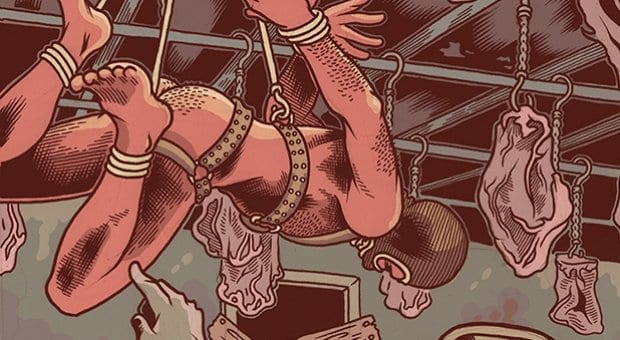I had my first orgasm in about 1998. I was sitting in a creaky, 1970s green chair in my grandma’s basement. It was unexpected, confusing and glorious, and while I would have further orgasms (especially that summer, all summer), this particular one is very important. If that chair were to be preserved somehow — as part of an unlikely tribute to my grandma’s house, for instance — it would go on existing, and people would look at it and think, “What an ugly ’70s chair,” but its significance to my life would be lost on them. I could go and put a sign next to it that says, “Here is the site of Jeremy’s terrifying inaugural splooge,” and people would understand, but if I didn’t, then the chair would exist only as a monument to ugly chairs and the generations of Willard asses that had occupied it. The chair’s history would be, in a sense, tidied up, with all my messy sperms forgotten and only the tamer, more socially acceptable history of the chair preserved. Many a sperm shed in New York City’s Meatpacking District is being forgotten as well.
The Meatpacking District is an area of Manhattan bordered by West 14th Street in the north, Gansevoort Street in the south, the Hudson River on the west side and Hudson Street on the east. Industrialization took hold of the area in the mid-19th century, when Fort Gansevoort was replaced by freight yards and other industry sprang up in the area, including iron works, lumber yards and granite works. By 1900, there were about 250 slaughterhouses and meatpacking plants in the area, and by the 1920s the focus was almost exclusively on meat-related industry. Warehouses, shedlike market buildings, huge slabs of meat hanging on hooks, and workers sporting blood-spattered aprons became the scenery of the district.
A decline in the meatpacking industry in the 1960s meant that through the 1970s and 1980s the area was a hotspot for gay nightclubs. With its uninhabited warehouses and poorly policed streets, the district became a haunt for gays, transgender people, sex workers and other “sexual deviants” looking for a place where they could be themselves and fuck. A plethora of fetishes and the spectrum of BDSM delights were the focus of such nightclubs as The Zoo, Mineshaft, Assterick, Anvil, Cell Block and Manhole. For many, the freedom of the Meatpacking District was their way of combating society’s ideas about sexual morality.
With AIDS in full swing, the city closed down the Mineshaft in 1985. In the 1990s, Mayor Rudy Giuliani’s “clean-up” efforts wiped out much of what remained of the queer scene in the district. The area’s edge has been dulled by gentrification, and now the most common sight in the region is probably Sarah Jessica Parker look-alikes blithering in high-end restaurants or trotting along West 14 Street and double-fisting lattes while browsing clothing labels like Alexander McQueen and Diane Von Fürstenberg. The success of the High Line project — the conversion of the abandoned elevated railway that runs through the Meatpacking District into a public park — has spurred rent increases and real estate development in the region. New York magazine has called the Meatpacking District “New York’s most fashionable neighbourhood.”
Meanwhile, quite a lot of preservation is going on. In 2003 Gansevoort Market District was designated a historic site, and then in 2007 the Greenwich Village Society for Historic Preservation announced that New York State Parks was going to make the entire Meatpacking District historic. Restrictions have been placed on development in the area, but what is really being preserved? So far, I haven’t read that any trace of the memory of the queer scene of the 1970s and ’80s is being maintained. Some of the buildings may continue to stand, but without anything to indicate what those buildings mean to the queer community, they’re just charming old industrial buildings to titillate rich people who love all things vintage. And like the green chair in the hypothetical tribute to my grandma’s house, the district’s history might end up “tidied up” as a result, all sperms lost to history. Without some greater effort to maintain the messy, kinky and sexually deviant past of the district, that part of its history may be lost.
(History Boys appears on Daily Xtra on the first and third Tuesday of every month. You can
also follow them on Facebook.)


 Why you can trust Xtra
Why you can trust Xtra


